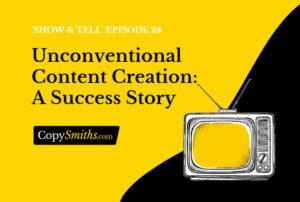Home » Content Marketing » 3 Content Marketing Strategies You Need to Try in 2022

3 Content Marketing Strategies You Need to Try in 2022
Don’t work hard.
Work smart. It is the secret to creating an effective content marketing strategy in 2022.
You are probably feeling the pressure to deliver fresh, engaging blog posts consistently.
Readers are more impatient than ever. They want answers, and they want them immediately when they land on your website.
They are more intelligent, too; your only choice is to publish a relevant piece of content each time.
So, how do you create content that meets your readers’ demands without driving your in-house writers to exhaustion? You come up with a smart content marketing strategy that saves you time.
Here are three tactics that will help you create a content marketing strategy that brings results in 2022.
Curate Content Like a Pro
Of all content marketing methods, blogging is the most effective for distributing content and establishing a web presence. However, blogging consistently can be time and labor-consuming. Plus, getting fresh ideas to create content with can be a pain.
The good news is, you do not always have to create great content from scratch.
Curate high-quality information from various sources, organize it, and because you know what your customers want – include a unique commentary.
According to the Content Marketing Institute, content curation is one of the most cost-effective content marketing methods.
Moreover, your readers will go looking for information from multiple sources on their own – why not bring it all to them in one post?
Step 1: Collect High-Quality Content from Authority Websites
Choose a topic and research extensively for authority sites that have written about it. Put together valuable articles and multimedia content related to the topic.
Organize it in subheadings to provide in-depth information to your reader as they scroll down the page. Remember to design for user experience first – the flow should be logical.
Step 2: Add Your Commentary
Curating content is not just compiling other people’s content and sharing it. The Content Marketing Institute suggests adding editorial value through a commentary that reflects your brand.
Present valuable content, but do not leave it dangling for your audience to decipher. Break it down for your readers using examples.
Relate the content to your brand and the unique offerings you have. Using visuals such as infographics is another way to capture their attention.
Step 3: Stay relevant
Each page you curate into your post must be relevant to the topic. The purpose of curation is to provide a rich source of comprehensive information – ensure that each link your readers click on complements the content plan.
Step 4: Reach Out to Websites Whose Content You’ve Curated
No matter how well written your blog posts are, promoting them on your own, hoping to break through the clutter may frustrate your content marketing efforts.
Create time in your content calendar to reach out to bloggers whose posts you have curated. If it aligns with their content strategy, they will share it.
Repurpose Evergreen Content
Anybody who is somebody in the content marketing world will tell you that content matters. You agree, so you probably think creating content continuously until you meet your content marketing goals is a good idea.
That strategy may work at first, but not for long. Blog posts get stale, and their SEO capacity diminishes.
Not to mention how much time and resources you spend on fresh content. The solution? Evergreen content.
Content marketers may have to publish highly specific posts on current events every once in a while. However, they also create pieces of content that make sense months or years later.
Rather than base your content strategy on fresh ideas, repurpose evergreen posts.
Repurposing is adding value to content to reinforce your message and relate it to the current market.
Here is how to make the most of your evergreen content.
Step 1: Audit Existing Content to Find Posts That Performed Well
If a piece of content is performing poorly, repurposing it may not make much of a difference.
Audit your website to find the kind of content that is ranking well for organic visibility, linking structure, shares, and other vital metrics.
Step 2: Choose Posts That Match Your Current Goals
What is the ultimate goal of your content marketing strategy? Do you want to reach a specific audience? Perhaps you have an improved version of a product that you want to sell?
The best posts to repurpose are those that are in line with your business goals.
Putting the right content in front of the right user at the right time is a content marketing strategy that guarantees conversion.
Step 3: Repurpose Content
Repurposed content takes on a new form. You may simply republish it with a few tweaks on your website or as a guest blog on external sites.
Alternatively, use the following content marketing methods:
- Webinars
- Podcasts
- Videos
- Online courses
- Infographics
- Ebooks
- Email series
Retarget Your Users
Readers do not always convert to customers on their first visit to your site. Most readers will come, find their answers, and leave. According to Hubspot, 96% of visitors to a website leave without completing the action the marketer would have liked them to take.
Your job is to get readers to return so you can implement lead generation. Content retargeting/remarketing is the most effective strategy to use.
Remarketing gives you the unique opportunity to appear in front of people who have shown an interest in your brand. Below is how to use a content remarketing campaign to convert return visitors.
Step 1: Target New Users
Bounced website visitors are an audience worth targeting. Use parameters such as the number of page views or the specific pages they spent time on to understand their intent. Then, target them with a specific content marketing strategy.
For example, a visitor who read one blog post and bounced will need more convincing. He or she may come back if offered a free PDF checklist or any other informative and downloadable incentive. In return, they will leave their email address.
A recent visitor who read a post and checked out several products may return if offered a free trial. He or she will sign up for it with an email address.
Create a content marketing plan that uses metrics to establish an ideal target audience.
Step 2: Target Unresponsive Customers
Your content marketing strategy can target previously converted or existing customers to earn an upsell. You might have unresponsive email subscribers who haven’t purchased in a while.
Your content marketing program may involve personalized headlines for your emails. For example, “We miss you!” or “It’s been a while, hasn’t it?“
Alternatively, use social media for targeted ads. An unresponsive customer scrolling down their Facebook feed might act on a reminder to complete an action or information to help them make a buying decision.
CopySmiths
I'm Katrina McKinnon, founder of CopySmiths and Small Revolution. In my 20 years of experience, I have helped online businesses create high-performing content specifically on an eCommerce store's blog. Find me on LinkedIn and Twitter.

CopySmiths offers the best blog writing services for online stores.
If you'd like us to write blog articles for you, click here.
Most Recent
- 3 Bold Questions You Should Ask When Hiring A Content Writer

- 5 Practical Reasons You Should Use a Blog Post Template

- 4 Amazing Benefits of Using a Title Generator for New eCommerce Blogs

- 10 Awesome Bio Examples Your Online Store Blog Should Emulate

- 8 Basic Steps to Successful Content Development Every Time

Podcasts
Got a question?
Ask our friendly team about our article writing services.
Subscribe to CopyZine
Monthly, hand-picked stories of the best in eCommerce Content.




